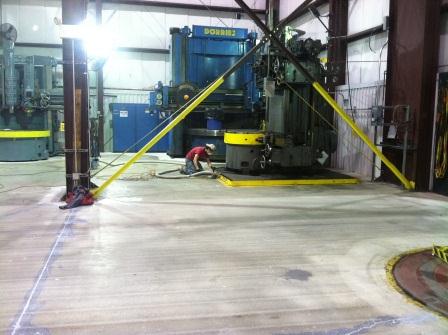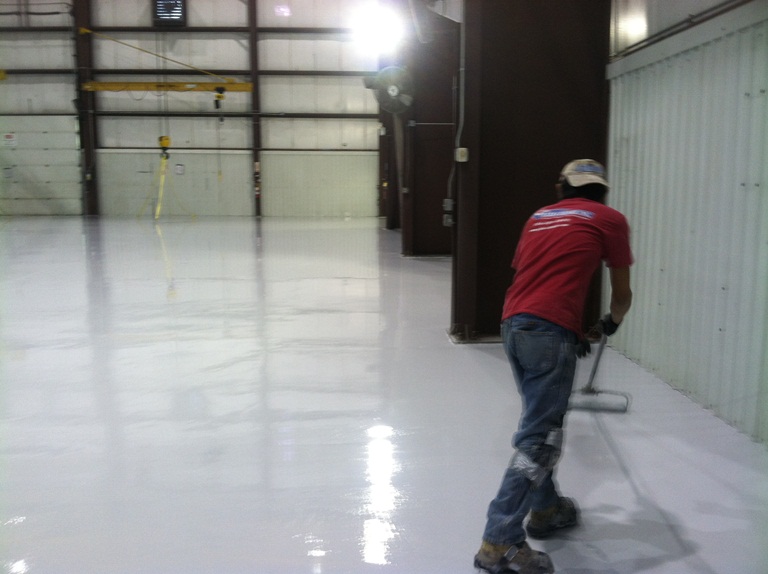When Industrial Flooring Specialists arrived on the scene for a coatings job at a machine shop in New England, they found a concrete floor that was stained and in need of some serious surface preparation. As the crew surveyed the area and readied themselves for a challenging prep and coatings project, they also had to deal with some frigid temperatures and the installation of three different Plexi-Chemie coating systems — PlexiGlaze IFF, PlexiQuartz CRI, and PlexiClad Deep Fill — in the large industrial space.
According to Pat Sicilia of Industrial Flooring Specialists, the concrete floors of machine shops and industrial plants take a real beating. And this particular 20,000-square-foot (1,858 m²) facility was no exception. “This machine shop manufactures special jet engine parts and handles parts from all over the world,” said Sicilia. The concrete substrate was severely stained with grease, machine oils, and other various contaminants. With these conditions, the 8-to-12-person crew knew that aggressive surface preparation was in order before they could even think about applying the Plexi-Chemie coating systems.
Prep, Prep, and More Prep
As all coating contractors should know, the coating system applied is only as good as the surface prep that comes before the installation. To ensure proper adhesion, the crew got down to work removing the stains that were deeply set into the concrete substrate. They shot blasted the surface with Blastrac shot blasters, but in some instances, this simply wasn’t enough. “In some areas that were deeply saturated with oil and grease, we had to shot blast two to three times,” revealed Sicilia. The team also had to use Von Arx scarifiers to really dig deep into the substrate in certain places throughout the machine shop.
In addition to having to use heavy duty prep equipment multiple times, the crew also had to contend with working around large machines that were not removed from the shop facility. To properly prepare the concrete substrate surrounding this existing machinery, the Industrial Flooring Specialist team used hand-held diamond grinders and surface prep tools. “We had to really be careful not only to make sure we properly prepped the concrete, but we also had to make sure no one got hurt while working in these tight spaces,” said Sicilia.
Healing the Concrete
 With the concrete substrate finally prepped, it was time for the crew to prime the surface. “With all the imperfections blown out by the shot blasting and scarifying, we were able to apply Plexi-Chemie’s PlexiGlaze #4 to the concrete,” said Sicilia. PlexiGlaze #4 is a 100 percent solids, clear epoxy flooring resin that acts as a penetrating primer. According to Sicilia, it “heals” the concrete, filling in gouges that may not be visible that could have impeded the proper adhesion of the coating system. “We apply it using a squeegee at about 10–15 mils [254–381 microns]. We allow it to cure overnight, and it fills all the cavities and joints. It provides an anchor for the rest of the coating system that will be applied,” said Sicilia. Although PlexiGlaze #4 cures into a very hard solid, it doesn’t become brittle; instead it retains enough resilience to withstand impact and vibration.
With the concrete substrate finally prepped, it was time for the crew to prime the surface. “With all the imperfections blown out by the shot blasting and scarifying, we were able to apply Plexi-Chemie’s PlexiGlaze #4 to the concrete,” said Sicilia. PlexiGlaze #4 is a 100 percent solids, clear epoxy flooring resin that acts as a penetrating primer. According to Sicilia, it “heals” the concrete, filling in gouges that may not be visible that could have impeded the proper adhesion of the coating system. “We apply it using a squeegee at about 10–15 mils [254–381 microns]. We allow it to cure overnight, and it fills all the cavities and joints. It provides an anchor for the rest of the coating system that will be applied,” said Sicilia. Although PlexiGlaze #4 cures into a very hard solid, it doesn’t become brittle; instead it retains enough resilience to withstand impact and vibration.
Coating Times Three
Once the substrate was primed, the crew applied PlexiGlaze IFF coating system to the majority of the machine shop floor. This coating system is a high-build pigmented epoxy with a polyester urethane topcoat. Using trowels, the crew applied two layers of PlexiGlaze IFF at an average thickness of 12 mils (305 microns) each. “We also fixed any areas that required repair using PlexiPatch QC. This patching compound can be used in between layers of the coating system and allows us to repair as we go,” said Sicilia. The crew then trowel-applied PlexiCrest P at a thickness of about 2 mils (51 microns). This polyester urethane topcoat is ultraviolet- (UV) and abrasion-resistant, as well as resistant to the oils and grease that will accumulate on the shop floor.
 There was about a 2,000-square-foot (186 m²) area in the facility that required the installation of the PlexiQuartz CRI system. This troweled and broadcast system is 100 percent solids clear epoxy resin and aggregate flooring system. “It is a 3/16-inch [5 mm] quartz floor that provides excellent impact resistance. We needed to use this system in the area where there would be heavy duty tractor trailers going back and forth on the floor. This area required a thicker, more impact resistant system,” said Sicilia. According to him, the majority of the facility would not see traffic like this, as much of the heavy lifting is done with overhead cranes.
There was about a 2,000-square-foot (186 m²) area in the facility that required the installation of the PlexiQuartz CRI system. This troweled and broadcast system is 100 percent solids clear epoxy resin and aggregate flooring system. “It is a 3/16-inch [5 mm] quartz floor that provides excellent impact resistance. We needed to use this system in the area where there would be heavy duty tractor trailers going back and forth on the floor. This area required a thicker, more impact resistant system,” said Sicilia. According to him, the majority of the facility would not see traffic like this, as much of the heavy lifting is done with overhead cranes.
The crew applied 1/8-inch (3 mm) self-leveling aggregate broadcast to the already primed substrate, and then they removed any excess aggregate. They applied a layer of PlexiGlaze #4 and then re-broadcast the 20/30 sand. This was followed by applying another layer of PlexiGlaze #4 and finally the PlexiCrest P topcoat.
The third coating system that was applied to approximately 300 square feet (28 m²) of the machine shop floor was PlexiClad Deep Fill. “The PlexiClad was applied in recessed areas that needed to be brought to the same elevation as the rest of the floor,” explained Sicilia. The crew used a power trowel to install two inches (5 cm) of the PlexiClad 100 percent solids epoxy resurfacer. Once the deep fill was applied and the recessed areas were level with the rest of the floor, the crew finished off the PlexiGlaze IFF system.
Throughout the entire prep and coating process, the Industrial Flooring Specialist team was extremely aware of any and all safety concerns. According to Sicilia, the crew wore hard hats, safety glasses, and steel-toed boots. They also wore respirators when working with the polyester urethane materials.
Cold Temps
Dealing with the logistics of this large-scale project would be difficult in any circumstance, but add in the biting cold of New England in January and the team was up against a serious challenge. “The outside temperature was only 15° F [-9° C]. There can be issues with the materials in temperatures that cold,” said Sicilia. Luckily, the crew was prepared for it. The materials that were shipped from the Florida-based warehouse were warmed up using large heating core elements over a three-day period prior to application. In addition, the Plexi-Chemie materials are flexible when it comes to temperature. “The Plexi-Chemie chemistry can be regulated according to ambient temperature. In other words, the reaction times can be sped up in cold temperatures and slowed down when it’s hot,” explained Sicilia.
Overcoming the Time Crunch
As if the crew didn’t have enough obstacles to overcome, the entire job had to be completed in one week. Although this circumstance proved to be challenging (and more than a little tiring), they completed the project in six days. “We worked a lot of overtime, but we were able to finish on time, in large part due to the experienced crew and the excellent products. We put down the right material for each portion of the facility. The machine shop now has a floor that is durable, impact- and abrasion-resistant, and will protect the concrete for years to come,” said Sicilia.
Heavy Duty Stains Equals Aggressive Prep from CoatingsPro Magazine on Vimeo.